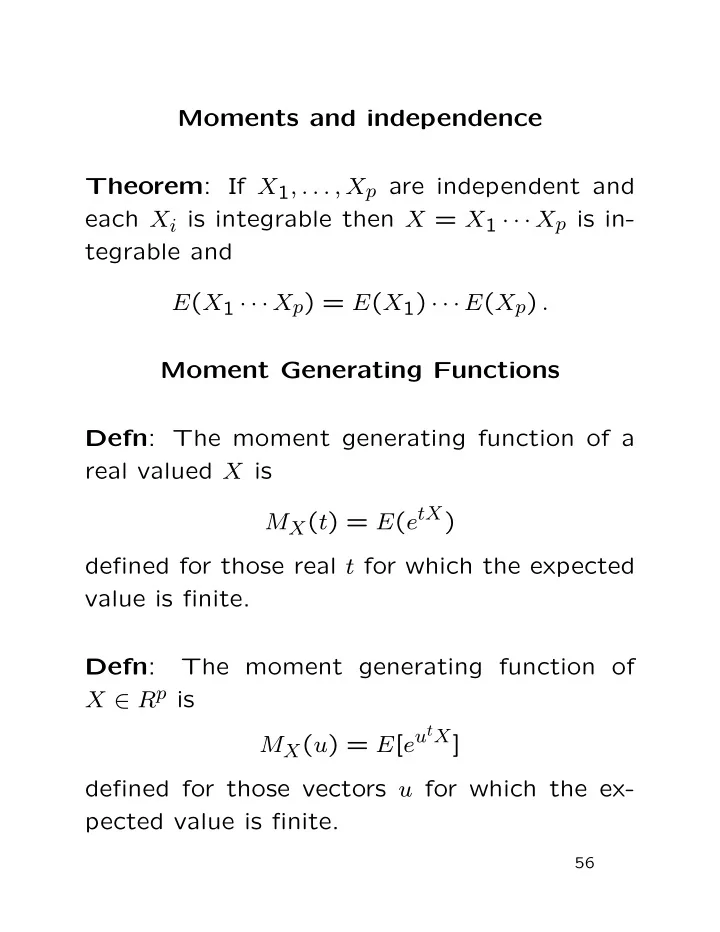

Moments and independence Theorem : If X 1 , . . . , X p are independent and each X i is integrable then X = X 1 · · · X p is in- tegrable and E ( X 1 · · · X p ) = E ( X 1 ) · · · E ( X p ) . Moment Generating Functions Defn : The moment generating function of a real valued X is M X ( t ) = E ( e tX ) defined for those real t for which the expected value is finite. Defn : The moment generating function of X ∈ R p is M X ( u ) = E [ e u t X ] defined for those vectors u for which the ex- pected value is finite. 56
Formal connection to moments: ∞ E [( tX ) k ] /k ! � M X ( t ) = k =0 ∞ k t k /k ! . � µ ′ = k =0 Sometimes can find power series expansion of M X and read off the moments of X from the coefficients of t k /k !. Example : : X has density f ( u ) = u α − 1 e − u 1( u > 0) / Γ( α ) MGF is � ∞ e tu u α − 1 e − u du/ Γ( α ) M X ( t ) = 0 Substitute v = u (1 − t ) to get M X ( t ) = (1 − t ) − α 57
For α = 1 get exponential distribution. Have power series expansion ∞ t k � M X ( t ) = 1 / (1 − t ) = 0 Write t k = k ! t k /k !. Coeff of t k /k ! is E( X k ) = k ! Example : : Z ∼ N (0 , 1). � ∞ √ −∞ e tz − z 2 / 2 dz/ M Z ( t ) = 2 π � ∞ √ −∞ e − ( z − t ) 2 / 2+ t 2 / 2 dz/ = 2 π = e t 2 / 2 because rest of integrand is N ( t, 1) density. 58
Theorem : If M is finite for all t ∈ [ − ǫ, ǫ ] for some ǫ > 0 then 1. Every moment of X is finite. 2. M is C ∞ (in fact M is analytic). k = d k 3. µ ′ dt k M X (0). C ∞ means has continuous derivatives Note: of all orders. Analytic means has convergent power series expansion in neighbourhood of each t ∈ ( − ǫ, ǫ ). Theorem : Suppose X and Y have mgfs M X and M Y which are finite for all t ∈ [ − ǫ, ǫ ]. If M X ( t ) = M Y ( t ) for all t ∈ [ − ǫ, ǫ ] then X and Y have the same distribution. The proofs, and many other facts about mgfs, rely on techniques of complex variables. 59
MGFs and Sums If X 1 , . . . , X p are independent and Y = � X i then the moment generating function of Y is the product of those of the individual X i : E ( e tY ) = E ( e tX i ) � i or M Y = � M X i . Note: also true for multivariate X i . Example : : If X i ∼ N ( µ i , σ 2 i ) then e t ( σ i Z i + µ i ) � � M X i ( t ) =E = e tµ i M Z i ( tσ i ) = e tµ i e t 2 σ 2 i / 2 = e σ 2 i t 2 / 2+ tµ i . Moment generating function for Y = � X i is exp { σ 2 i t 2 / 2 + tµ i } � M Y ( t ) = σ 2 i t 2 / 2 + � � = exp { µ i t } which is mgf of N ( � µ i , � σ 2 i ). 60
Example : Now suppose Z 1 , . . . , Z ν independent N (0 , 1) rvs. By definition: S ν = � ν 1 Z 2 i has χ 2 ν distribution. It is easy to check S 1 = Z 2 1 has density ( u/ 2) − 1 / 2 e − u/ 2 / (2 √ π ) and then the mgf of S 1 is (1 − 2 t ) − 1 / 2 . It follows that M S ν ( t ) = (1 − 2 t ) − ν/ 2 which is mgf of Gamma( ν/ 2 , 2) rv. So: χ 2 ν dstbn has Gamma( ν/ 2 , 2) density: ( u/ 2) ( ν − 2) / 2 e − u/ 2 / (2Γ( ν/ 2)) . 61
Example : The Cauchy density is 1 π (1 + x 2 ) ; corresponding moment generating function is � ∞ e tx M ( t ) = π (1 + x 2 ) dx −∞ which is + ∞ except for t = 0 where we get 1. Every t distribution has exactly same mgf. So: can’t use mgf to distinguish such distributions. Problem: these distributions do not have in- finitely many finite moments. So: in STAT 801, develop substitute for mgf which is defined for every distribution, namely, the characteristic function. 62
Recommend
More recommend